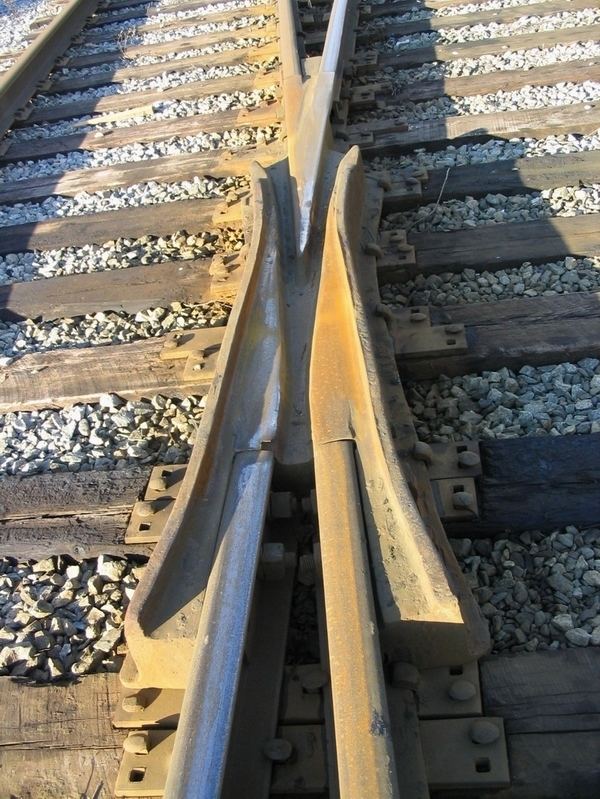In American railroading, a frog war occurs when a private railroad company attempts to cross the tracks of another, and this results in hostilities, with the courts usually getting involved, but often long after companies have taken the matter in their own hands and settled, with hordes of workers battling each other. It is named after the frog, the piece of track that allows the two tracks to join or cross and is usually part of a level junction or railroad switch.
Sometimes the first railroad was built specifically to delay the completion of the second.
It is generally the case that the second railway to arrive has to bear the cost of the special trackwork needed to cross the first. This includes the cost of any interlocking tower or signal box. The latter is not necessarily to the disadvantage of the second railway, since it can signal its trains through the junction ahead of those belonging to the first railway, depending on who employs the Signalman.
In the early days oil mostly travelled by rail, but gradually oil companies built oil pipelines. Not wanting to lose business, railway companies often refused permission to oil companies for pipelines to cross their tracks.
Bridges and riverboats
Abraham Lincoln participated in a celebrated court case that decided that railroads had as much right to bridge rivers as the riverboat had the right to navigate those rivers. Nova Scotia's Shubenacadie Canal was rendered useless by a railway bridge built across it in 1870.
Note: The first railroad line built is the first one named.
1853: Greater Grand Crossing, Chicago - feud between the Lake Shore and Michigan Southern Railway and the Illinois Central Railroad; both railroads ran through the junction essentially pretending the other didn't exist, finally resulting in a crash that killed 18 people.1867: South Carolina Railroad vs. Columbia and Augusta Railroad, later Charlotte, Columbia and Augusta Railroad. A grade crossing in Columbia was protested in court, then blocked by a parked train, then torn up physically and finally threatened by a steamed-up locomotive ready to move forward to block at any moment (Derrick: 245-246 and Fetters: 143).1870s: Denver and Rio Grande Western Railroad vs. Atchison, Topeka and Santa Fe Railroad vs. Union Pacific Railroad in Colorado; three railroads vying for suitable mountain passes.December 2, 1870–January 9, 1871: The Erie Railroad vs. Morris and Essex Railroad's Boonton Branch (Delaware, Lackawanna and Western Railroad) at the west end of the Erie's Long Dock Tunnel in Jersey City, New Jersey.January 6 and January 7, 1876: The Mercer and Somerset Railway (Pennsylvania Railroad) vs. the Delaware and Bound Brook Railroad (Reading Railroad) in Hopewell, New Jersey.August 7–September 13, 1883: Colton Crossing - the Southern Pacific Railroad vs. the California Southern Railroad (a subsidiary of the Atchison, Topeka and Santa Fe Railway) at Colton, California (just outside San Bernardino).March 1886: The Erie Railroad vs. the New Jersey Junction Railroad (New York Central Railroad) at King's Bluff near Weehawken, New Jersey.September 1891: The Central Railroad of New Jersey vs. the Jersey City, Newark and Western Railway (Lehigh Valley Railroad) in southern Jersey City, New Jersey.March 1894: The Cape May and Millville Railroad (Pennsylvania Railroad) vs. the Tuckahoe and Cape May Railroad (Reading Railroad) at Woodbine Junction, New Jersey1897: The Pennsylvania Railroad vs. the New Jersey Junction Connecting Railway (Lehigh Valley Railroad) in Jersey City, New Jersey.December 1897: Again, the Pennsylvania Railroad, vs. the Newtown Electric Street Railway in Langhorne, Pennsylvania. Not a true "frog" war per se, the trolley line attempted to build a line parallel to a turnpike running underneath the PRR tracks on an underpass. For a duration, passengers had to walk through the underpass to meet trolleys on both sides before the war was waged.Battle of Havant. Conflict of London and South Western Railway with the London, Brighton and South Coast Railway over the building of the Portsmouth branchNickey LineConflict between the London, Brighton and South Coast Railway and South Eastern Railway for access to Hastings and St Leonards beyond Bo Peep Junction (also see St Leonards West Marina railway station)
